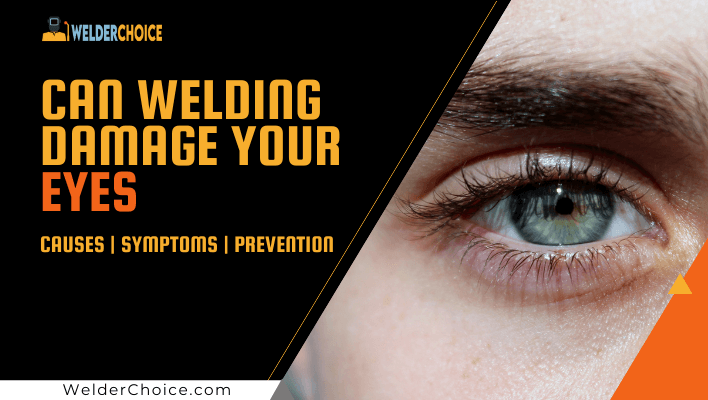Can Welding Damage Your Eyes, Yes More 20% of welding injuries are eye injuries. Learn how to take safety steps and stay safe when welding on your next project!
Welding can cause eye damage due to UV radiation and flying debris, if the correct welding safety precautions are not followed. Because eye injuries account for 25% of all welding injuries, proper eye protection is essential in the workplace.
The good news is that the vast majority of these eye injuries are preventable and, in most cases, reversible. To put that into perspective, almost all welders who suffer eye injuries return to work within a week, and more than half return within two days.
The debris kicked up during brushing, grinding, or chipping is potentially damaging to unprotected eyes. The UV and infrared radiation emitted by the welding arc and molten metal, on the other hand, receives more attention. We’ll look at why welders face such a challenging problem today.
UV And Infrared Radiation Causes Problems
All major types of welding emit UV radiations, visible spectrum, and infrared radiation. The arcs of other welders can also injure your eyes because reflected light may include radiation. UV radiation is absorbed by the lens and cornea, in particular, resulting in puffy, hurting eyes. Thankfully, this isn’t always the case.
This sort of eye damage causes photokeratitis, sometimes known as “welder’s flash.” Even while it’s brutally unpleasant, it’s not irreversible. However, long-term exposure to this type of radiation can cause the lens and cornea to yellow. If this happens, you’ll have difficulties with contrast in your eyesight.
Symptoms of welder’s flash include:
- Pain ranging from mild to severe in one or both eyes.
- Irritation of the eyes is a condition in which the eyes get irritated.
- The vision is blurry.
- The sensitivity to light has enhanced.
- Eyes that are dripping with tears
- Eyes that are swollen and bloodshot
You could develop cataracts as a result of persistent retinal damage in the worst-case scenario. Although temporary (if unpleasant) welding eye problems are considerably more common than serious and long-term issues, safety is still paramount, so make sure you’re covered when you’re in the shop.
How to Protect Your Eyes When Welding
An ANSI-approved helmet is the first piece of gear you’ll need. UV and infrared protection is provided by all auto-darkening helmets that meet the ANSI Z87.1 criteria.
However, because a lot of welding is done with the helmet lifted, this isn’t enough to keep your eyes safe. Make sure you’re protected from the sun with UV-protective safety glasses. Depending on your preferences, you can pick between clear and shaded glasses.
UV protection has nothing to do with the darkness of your glass’s lenses. In fact, dark glasses with minimal UV protection can be worse than none at all. Your pupils dilate when you’re in the dark, exposing your retinas to unfiltered ultraviolet radiation. Don’t settle for the cheapest pair of sunglasses; look for ones that offer 100 percent UV protection.
Even if you’re standing up to 50 feet away from someone who is welding, you should wear eye protection since indirect exposure can cause damage to your eyes.
When arc welding, you should cover your glasses with a face shield. You’ll need a shield and glasses with a shade rating of 3 to 8 during gas welding.
Radiation Can Damage Your Eyes When Welding?
No flash burns are the most prevalent and serious form of eye injury while welding, but radiation isn’t the only thing that can injure your eyes. Many other occupations in welding shops release particles into the air, which might harm your eyes if you don’t use eye protection.
Angle grinders can throw debris into the air, and any cutting tool, from band saws to chop saws, can make projectiles. Sanding, polishing, and notching pipe can all be dangerous for the same reason.
Every year, thousands of people are not just injured but also blinded at work. Even worse, using the correct eye protection can prevent 90% of all eye injuries.
Conclusion
A welder’s flash is a potential occupational danger that can be avoided by following acceptable safety practices. Helmets, safety glasses, and protective clothing can help prevent welder’s flash and other serious eye injuries.
Don’t let yourself become a statistic because you couldn’t find your glasses straight away and decided to take a chance. Wear them at all times, even if it takes a few minutes to rustle up your safety gear.

With 8 years of experience a senior welding instructor and safety equipment researcher and writes articles, reviews and guidelines on helmets and other welding and safety gears at Welder Choice, and other written works have been published in various publications.
